A System for the Inclusion of the Informal Recycling Sector (IRS) in Mexico City’s Solid Waste Management
Abstract
:1. Introduction
2. Materials and Methods
2.1. Case Study
2.1.1. Solid Waste Management in Mexico City
2.1.2. Materials and Value Chain Interface in Mexico City
2.1.3. Social Interface
2.2. Viable System Model
- Costumers: the beneficiaries or victims of the transformation process;
- Actors: those who carry out the transformation processes;
- Transformation: the conversion of inputs and outputs;
- Weltanschauung: vision of the world that makes transformation relevant;
- Owners: those who can prevent the transformation;
- Environment: elements outside the system that restrict inputs and outputs.
3. Results
3.1. Identity
3.2. Structural Activities
3.3. Unfolding Complexity
3.4. Modeling
3.4.1. Modeling Productive Unit
3.4.2. Modeling Neighborhood
3.4.3. Borough
4. Discussion
4.1. Productive Unit
4.2. Neighborhood
4.3. Boroughs
5. Conclusions
Author Contributions
Funding
Data Availability Statement
Conflicts of Interest
Appendix A
| Material | Percentage | Ton/Day | $/Ton |
|---|---|---|---|
| Cardboard | 4.0% | 523.82 | 1800.00 |
| Paper | 5.9% | 765.58 | 2000.00 |
| Ferrous | 1.2% | 150.78 | 3450.00 |
| Non-ferrous | 0.3% | 37.69 | 3555.00 |
| Glass | 2.7% | 344.45 | 850.00 |
| Plastics Recyclables (Drink bottles) | 4.2% | 547.37 | 4500.00 |
| Total | 18.2% | 2369.69 | 2483.10 |
References
- Velis, C.A.; Wilson, D.C.; Rocca, O.; Smith, S.R.; Mavropoulos, A.; Cheeseman, C.R. An analytical framework and tool (‘InteRa’) for integrating the informal recycling sector in waste and resource management systems in developing countries. Waste Manag. Res. 2012, 30, 43–66. [Google Scholar] [CrossRef] [Green Version]
- Wilson, D.C.; Rodic, L.; Scheinberg, A.; Velis, C.A.; Alabaster, G. Comparative analysis of solid waste management in 20 cities. Waste Manag. Res. 2012, 30, 237–254. [Google Scholar] [CrossRef] [PubMed] [Green Version]
- Wilson, D.C.; Velis, C.; Cheeseman, C. Role of informal sector recycling in waste management in developing countries. Habitat Int. 2006, 30, 797–808. [Google Scholar] [CrossRef]
- Mavropoulos, A.; Willson David, C.; Appelqvlst, B.; Vells, C.; Cooper, J. Globalization and Waste Management Phase 1: Concepts and Facts; International Solid Waste Association: Vienna, Austria, 2012. [Google Scholar]
- Mavropoulos, A. How Industry 4.0 Transforms the Waste Sector; International Solid Waste Association: Rotterdam, The Netherlands, 2019. [Google Scholar]
- United Nations World Urbanization Prospects: The 2009 Revision; UN: New York, NY, USA, 2017.
- INEGI. Cuaderno Estadístico y Geográfico de la Zona Metropolitana del Valle de México 2014, 1st ed.; Instituto Nacional de Estadística y Geografía: Ciudad de México, Mexico, 2014; ISBN 978-607-739-481-5. [Google Scholar]
- Guibrunet, L. What is “informal” in informal waste management? Insights from the case of waste collection in the Tepito neighbourhood, Mexico City. Waste Manag. 2019, 86, 13–22. [Google Scholar] [CrossRef] [PubMed]
- Secretaría del Medio Ambiente del Gobierno de la Ciudad de México. Inventario de Residuos Sólidos de la Ciudad de México 2019; Secretaría del Medio Ambiente de la Ciudad de México: Ciudad de México, Mexico, 2020. [Google Scholar]
- Gutiérrez-Galicia, F.; Coria-Páez, A.L.; Tejeida-Padilla, R. A Study and Factor Identification of Municipal Solid Waste Management in Mexico City. Sustainability 2019, 11, 6305. [Google Scholar] [CrossRef] [Green Version]
- Secretaría del Medio Ambiente del Gobierno de la Ciudad de México. Inventario de Residuos Sólidos CDMX 2018; Secretaría del Medio Ambiente de la Ciudad de México: Ciudad de México, Mexico, 2019. [Google Scholar]
- Durán, A.; Garcés, M.; Velasco, A.; Marín, J.C.; Gutiérrez, R.; Moreno, A.; Delgadillo, A. Mexico City’s municipal solid waste characteristics and composition analysis. Rev. Int. Contam. Ambie 2013, 29, 39–46. [Google Scholar]
- Mavropoulos, A. Globalization, Megacities and Waste Management; International Solid Waste Association: Athens, Greece, 2010. [Google Scholar]
- Aparcana, S. Approaches to formalization of the informal waste sector into municipal solid waste management systems in low- and middle-income countries: Review of barriers and success factors. Waste Manag. 2017, 61, 593–607. [Google Scholar] [CrossRef] [PubMed] [Green Version]
- Wilson, D.C.; Araba, A.O.; Chinwah, K.; Cheeseman, C.R. Building recycling rates through the informal sector. Waste Manag. 2009, 29, 629–635. [Google Scholar] [CrossRef]
- Abarca Guerrero, L.; Maas, G.; Hogland, W. Solid waste management challenges for cities in developing countries. Waste Manag. 2013, 33, 220–232. [Google Scholar] [CrossRef]
- Gutberlet, J. Informal and Cooperative Recycling as a Poverty Eradication Strategy. Geogr. Compass 2012, 6, 19–34. [Google Scholar] [CrossRef]
- Dias, S.M. Overview of the Legal Framework for Inclusion of Informal Recyclers in Solid Waste Management in Brazil. Women in Informal Employment: Globalizing and Organizing. 2011. Available online: https://www.wiego.org/sites/default/files/publications/files/Dias_WIEGO_PB6.pdf (accessed on 9 November 2021).
- Terraza, H.; Sturzenegger, G. Dinámicas de organización de los recicladores informales. Tres casos de estudio en América Latina. Sector de infraestructura y medio ambiente. Nota Técnica N° 2010, 117, 30–42. [Google Scholar]
- Pfammatter, R.; Schertenleib, R. Non-Governmental Refuse Collection in Low-Income Urban Areas: Lessons Learned from Selected Schemes in Asia, Africa and Latin America; Department of Water and Sanitation in Developing Countries: Duebendorf, Switzerland, 1996. [Google Scholar]
- Nas, P.; Jaffe, R. Informal Waste Management. Environ. Dev. Sustain. 2004, 6, 337–353. [Google Scholar] [CrossRef]
- Scheinberg, A.; Savain, R. Valuing Informal Integration: Inclusive Recycling in North Africa and the Middle East; Deutsche Gesellschaft für Internationale Zusammenarbeit (GIZ) GmbH: Tunis, Tunisia, 2015. [Google Scholar]
- Jackson, M.C. Systems Thinking: Creative Holism for Managers, 1st ed.; J. Wiley: West Sussex, UK, 2003; ISBN 9780470845226. [Google Scholar]
- Instituto de Estadística y Geografía. Censo Nacional de Gobiernos Municipales y Delegacionales. 2017. Available online: https://www.inegi.org.mx/programas/cngmd/2017/#Tabulados (accessed on 9 November 2021).
- Castillo Berthier, H. Garbage, work and society. Resour. Conserv. Recycl. 2003, 39, 193–210. [Google Scholar] [CrossRef]
- Guibrunet, L.; Sanzana Calvet, M.; Castán Broto, V. Flows, system boundaries and the politics of urban metabolism: Waste management in Mexico City and Santiago de Chile. Geoforum 2017, 85, 353–367. [Google Scholar] [CrossRef] [Green Version]
- Coffey, M.; Coad, A. Collection of MSW in Developing Countries; UN-HABITAT: Tarxien, Malta, 2010; ISBN 978-92-1-132254-5. [Google Scholar]
- Couto, I.; Hernández, A. Participación y rendimiento de la iniciativa privada en la gestión integral de los residuos sólidos urbanos en la frontera México-Estados Unidos. Gestión Política Pública 2012, 21, 215–261. [Google Scholar]
- Guevara-García, J.A.; Montiel-Corona, V. Pushing Mexico to a recycling culture. In Mexico in Focus; Galindo, J., Ed.; Nova Science Publishers, Inc.: New York, NY, USA, 2015; pp. 141–176. ISBN 978-1-63321-885-7. [Google Scholar]
- CNICP. Plan de Manejo Para los Residuos de Papel y Cartón en México; Cámara Nacional de las Industrias de la Celulosa y del Papel: Ciudad de México, Mexico, 2012. [Google Scholar]
- Asamblea Legislativa del Distrito Federal. Ley de Residuos Sólidos del Distrito Federal. Gac. Of. del Dist. Fed. 2003, 13, 2–20. [Google Scholar]
- Secretaría del Medio Ambiente de la Ciudad de México. Norma ambiental para el distrito federal NADF-024-AMBT-2013, que establece los criterios y especificaciones técnicas bajo los cuales se deberá realizar la separación, clasificación, recolección selectiva y almacenamiento de los residuos del Distrito Feder. Gac. Of. del Dist. Fed. 2015, 18, 22–43. [Google Scholar]
- Jefatura de Gobierno. Programa de Gestión Integral de Residuos para la Ciudad de México 2021–2025. Gac. Ciudad México 2021, 21, 4–61. [Google Scholar]
- Jiménez-Martínez, N.M. The governance of waste: Formal and informal rules in the central region of Mexico. Reg. Stud. Reg. Sci. 2018, 5, 353–360. [Google Scholar] [CrossRef] [Green Version]
- Espinosa, A.; Harnden, R.; Walker, J. A complexity approach to sustainability–Stafford Beer revisited. Eur. J. Oper. Res. 2008, 187, 636–651. [Google Scholar] [CrossRef]
- Ramírez-Gutiérrez, A.G.; Cardoso-Castro, P.P.; Tejeida-Padilla, R. A Methodological Proposal for the Complementarity of the SSM and the VSM for the Analysis of Viability in Organizations. Syst. Pract. Action Res. 2020, 34, 331–357. [Google Scholar] [CrossRef]
- Beer, S. The Viable System Model: Its Provenance, Development, Methodology and Pathology. J. Oper. Res. Soc. 1984, 35, 7. [Google Scholar] [CrossRef]
- Checkland, P. Soft Systems Methodology: A Thirty Year Retrospective. Syst. Res. Behav. Sci. Syst. Res 2000, 17, 11–58. [Google Scholar] [CrossRef]
- Ríos, J.P. Models of organizational cybernetics for diagnosis and design. Kybernetes 2010, 39, 1529–1550. [Google Scholar] [CrossRef] [Green Version]
- Núñez-Ríos, J.E.; Aguilar-Gallegos, N.; Sánchez-García, J.Y.; Cardoso-Castro, P.P. Systemic Design for Food Self-Sufficiency in Urban Areas. Sustainability 2020, 12, 7558. [Google Scholar] [CrossRef]
- INEGI. Bienvenidos a Cuéntame de México. Instituto Nacional de Geografía y Estadística. 2015. Available online: http://cuentame.inegi.org.mx/ (accessed on 9 November 2021).
- Secretaría del Medio Ambiente de la Ciudad de México. PGIRS 2016–2020; Secretaría del Medio Ambiente de la Ciudad de México: Ciudad de México, Mexico, 2016. [Google Scholar]
- Secretaría del Medio Ambiente de la Ciudad de México. Programa de Gestión Integral de los Residuos Sólidos para el Distrito Federal 2009–2014. Gac. Dist. Fed. 2009, 17, 25–133. [Google Scholar]
- Supraciclaje Precios Hoy. Supraciclaje. 2020. Available online: https://www.supraciclaje.com/precios-hoy/ (accessed on 13 March 2020).
- Muñoz-Cadena, C.E.; Arenas-Huertero, F.J.; Ramón-Gallegos, E. Comparative analysis of the street generation of inorganic urban solid waste (IUSW) in two neighborhoods of Mexico City. Waste Manag. 2009, 29, 1167–1175. [Google Scholar] [CrossRef]
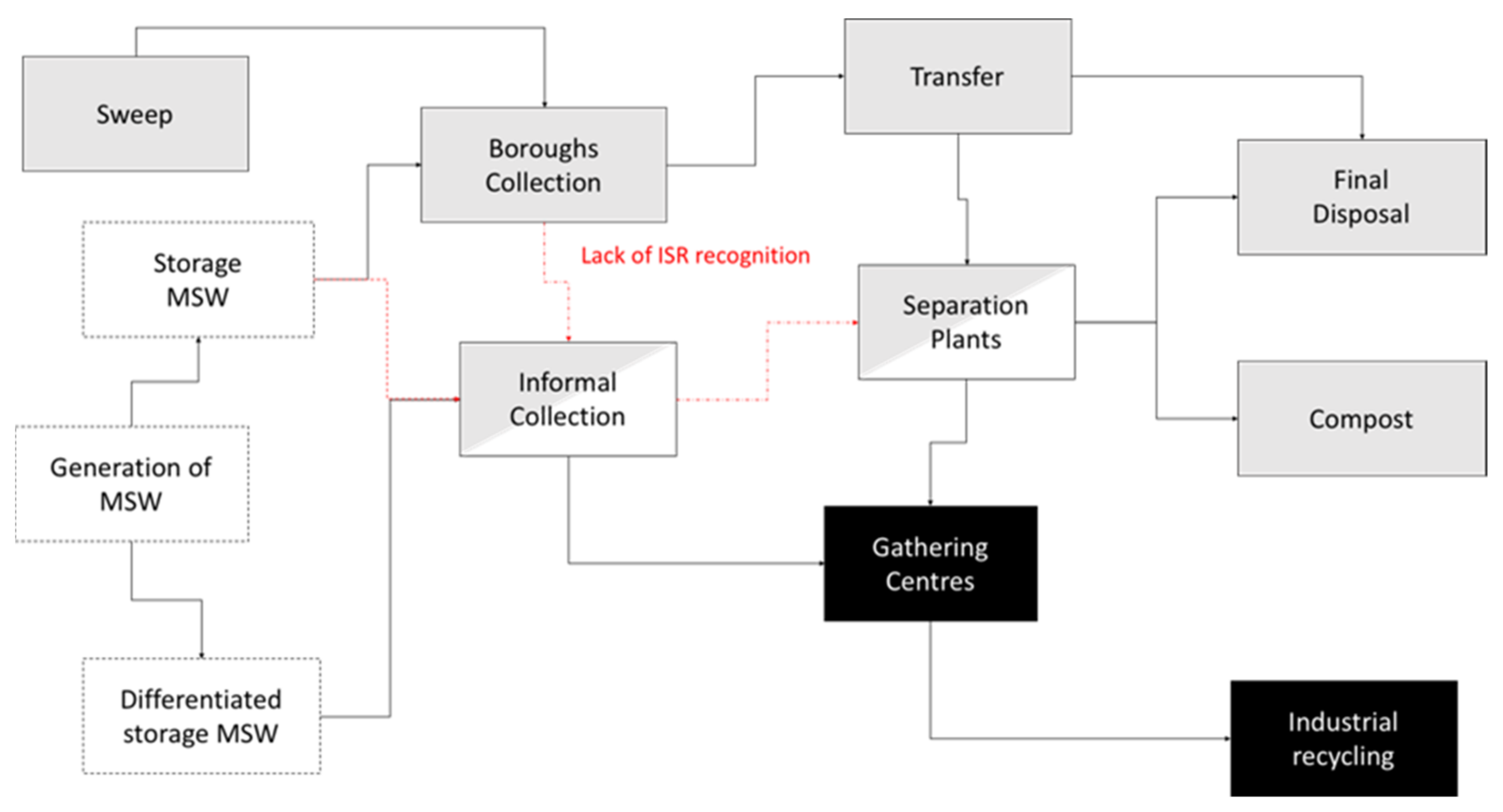
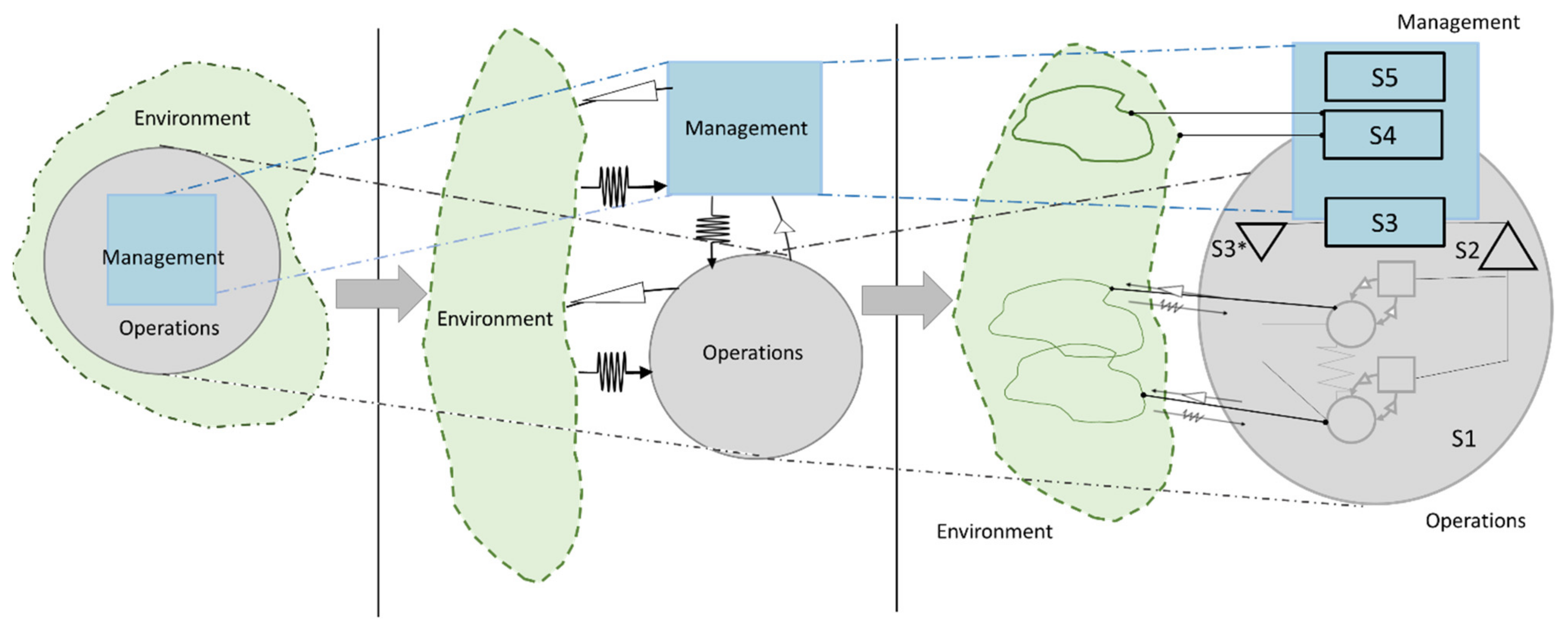
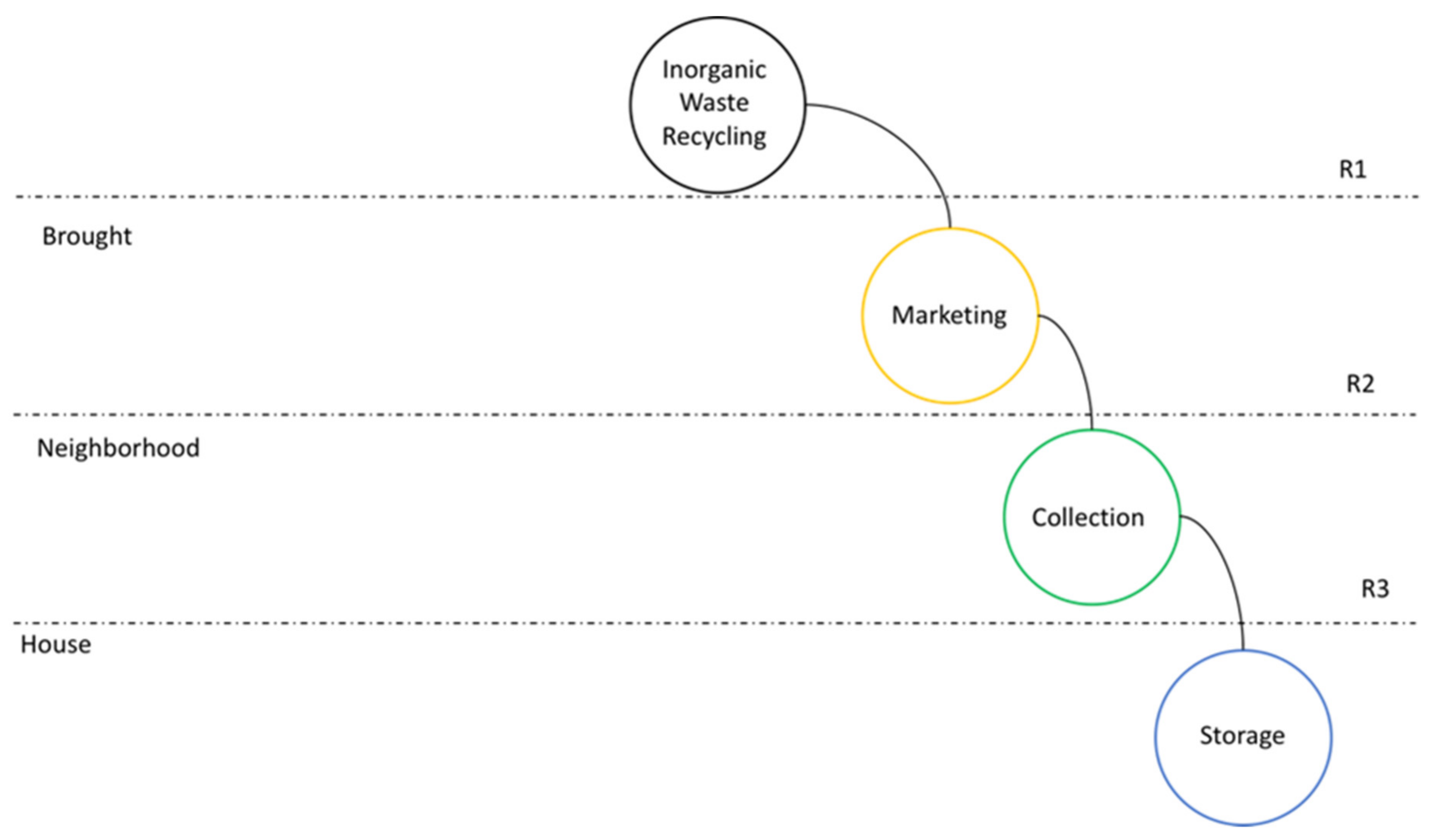
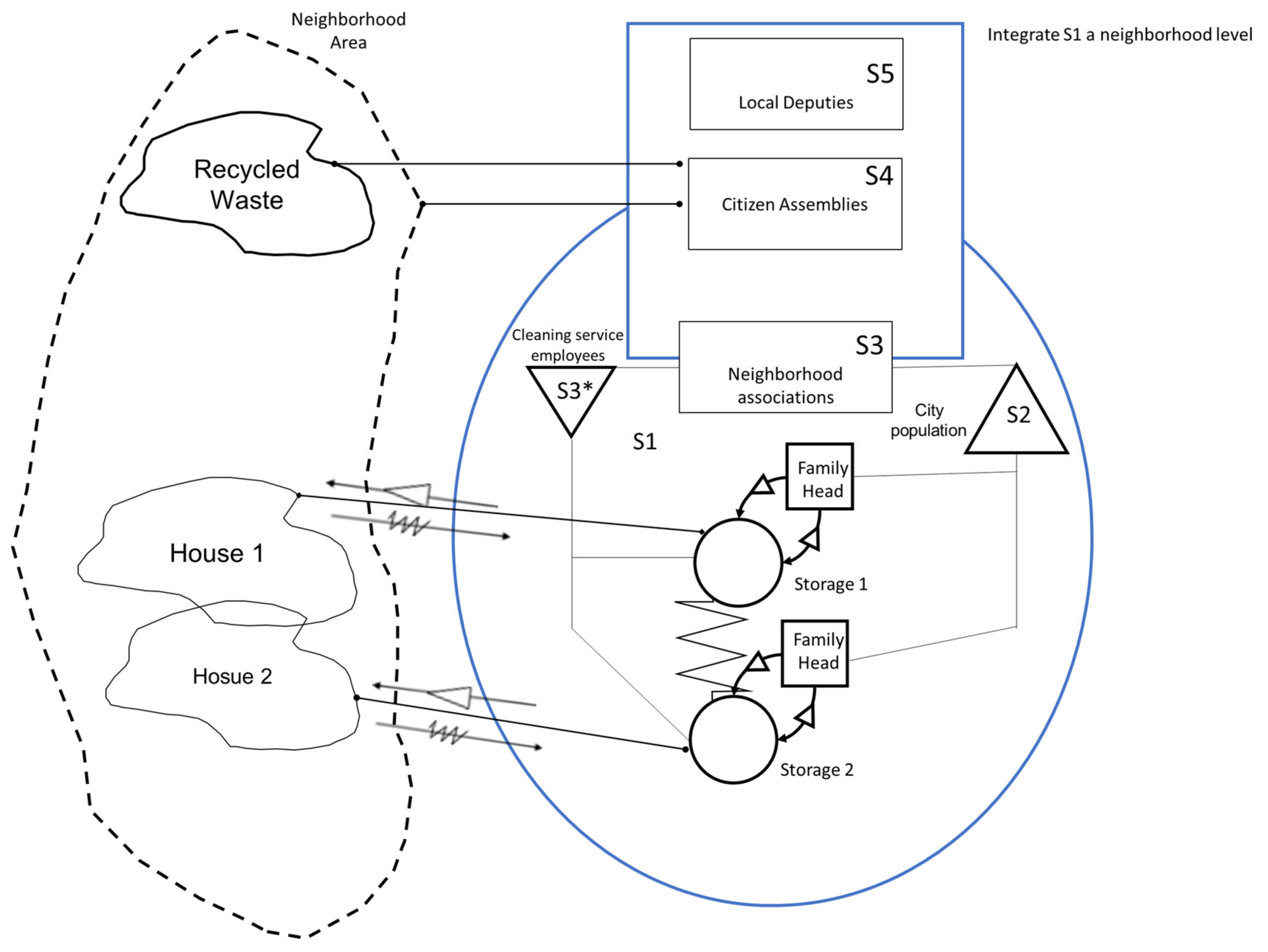

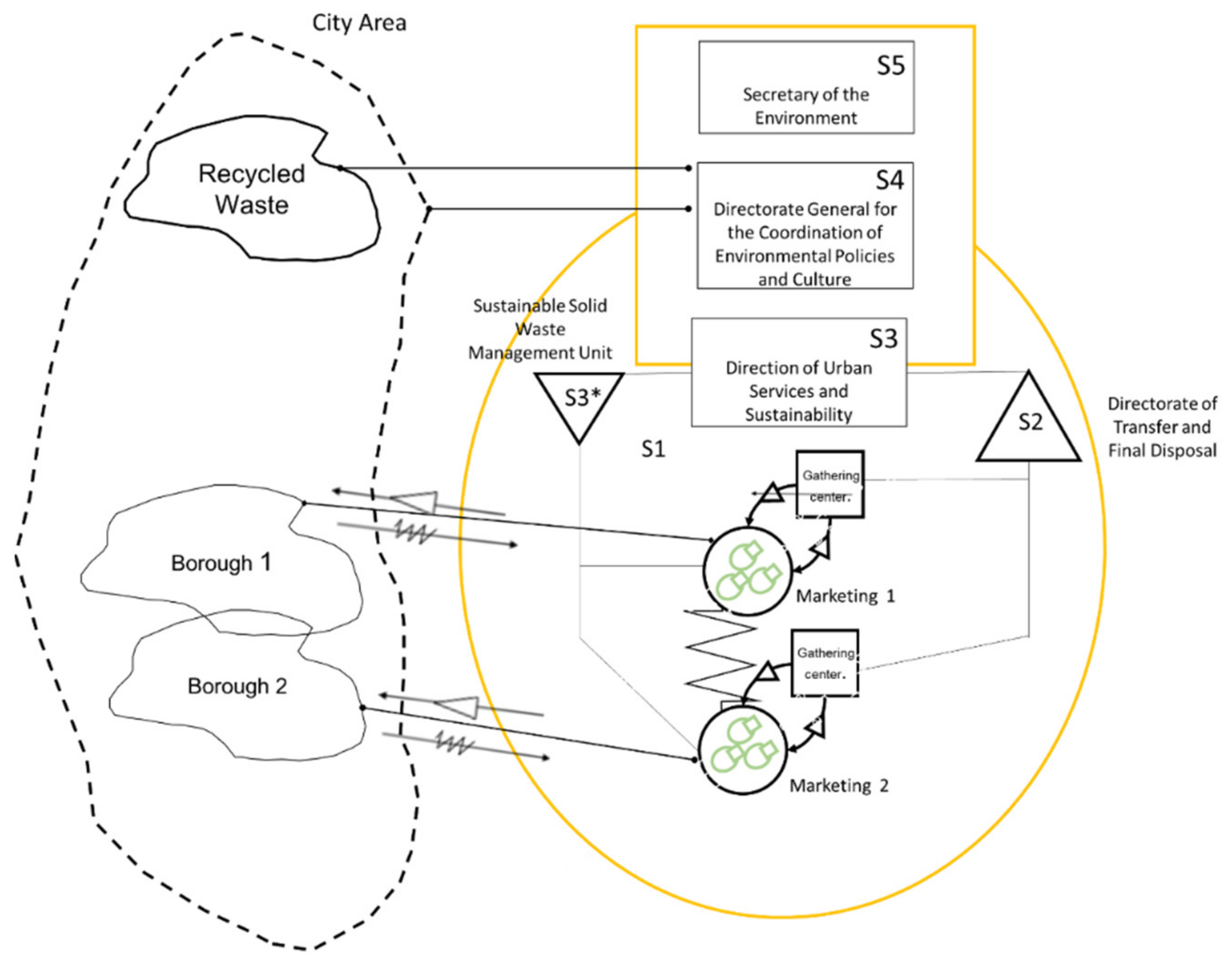
| System 1 | Definition |
|---|---|
| S1 | This function defines the organization. The primary activities are reflected—those that constitute the reason for the organization’s existence—giving it purpose and defining its identity. |
| S2 | This function allows languages and protocols of communication between primary activities of the same recursive level to take care of the consolidation and cohesion of the system in the execution of its tasks. |
| S3 | This function, often called “the inside and the now”, requires a precise appreciation of the achievements and capabilities of S1 and the coordination of potentialities and requirements to respect and enable the autonomy of primary activities to establish communication between S3 and 4. |
| S3* | This function corresponds to intermittent monitoring, which ensures the desired behavior of the primary activities. |
| S4 | This function is known as “intelligence” and is concerned with the organization’s environment and its prospective and future development (opportunities and threats), facilitating its adaptation. |
| S5 | This function, known as “politics”, is normative and responsible for closing the viable system, taking care of the integrity and organizational identity of the system. |
| Element | Definition |
|---|---|
| Customers | ISR that collects recyclable MSW. |
| Actors | The city population, Informal Sector Recyclers (ISRs), cleaning services, and environmental authorities. |
| Transformation | Storage and classification of recyclable waste. |
| Weltanschauung | One of the main problems in urban areas is the waste generation, so separation at the source is necessary to recycle as much waste as possible. |
| Owners | City Environmental Authorities Regulating MSW Classification. |
| Environment | Consumption habits of Mexico City inhabitants and the regulations regarding the separation of waste. |
| System | Definition |
|---|---|
| S1—Recycling | Differentiated recyclable MSW. |
| S2—Local Information and coordination | The city population, which is organized, separates and stores its waste. The head of the family is the determining factor for separating the MSW in the house. |
| S3—Productive Unit (PU) Management | Neighborhood associations regulate the types of storage, schedules, and locations for their proper collection. |
| S3*—PU Monitoring | Collection service workers that verify the efficiency in the classification of the MSW. |
| S4—PU Planning | Citizen assemblies is the highest community decision-making body in each of the territorial units. |
| S5—PU Board | Local deputies propose and approve the laws, regulations, and budget of the city. |
| Element | Definition |
|---|---|
| Customers | Gathering center. |
| Actors | House, ISR, cleaning services, and collection centers. |
| Transformation | Collection of waste classified as recyclable. |
| Weltanschauung | The collection of recyclable waste is a job opportunity for the most vulnerable sectors that cannot obtain formal employment due to their lack of education. |
| Owners | ISR collects recyclable waste. |
| Environment | The lack of waste separation at the source contaminates the recyclable materials and decreases their quantity and value. |
| Scheme 1 | Definition |
|---|---|
| S1—Recycling | Recyclable waste collection by the ISR. |
| S2—Neighborhood Information and Coordination Unit | The cleaning service collection routes and the ISR cover the assigned route without interfering with other courses. |
| S3—Neighborhood Management | Departmental cleaning and collection units of the municipalities that design the ISR collection routes and the cleaning services. |
| S3*—Neighborhood Monitoring | Cleaning supervisors of the municipalities verify that the collection routes are covered in their entirety. |
| S4—Neighborhood Planning | The borough’s urban services establish programs for the provision of the public cleaning services according to local regulations and the needs of the population. |
| S5—Neighborhood Board | The borough’s councilors represent the population, who, together with the local borough authorities, propose and approve projects to improve MSW management. |
| Element | Definition |
|---|---|
| Customers | Recycling centers buy wholesale recyclable waste from collection centers to be compacted or crushed and sold in bulk for industrial recycling within or outside the country. |
| Actors | Collection centers, informal recycling sectors, collection centers, and industrial recycling. |
| Transformation | Marketing of recyclable waste, such as cardboard, paper, beverage containers, metals, and glass. |
| Weltanschauung | Industrial recycling of waste contributes to sustainable development by reducing the exploitation of natural resources in the production of new products. |
| Owners | Collection centers buy the waste that the informal sector recovers on a small scale according to the market demand for materials. |
| Environment | Commodity market conditions and regulations regarding the manufacture of products with recycled materials. |
| System | Definition |
|---|---|
| S1—Recycling | Gathering center |
| S2—Borough and Coordination Unit | The Executive Directorate of Transfer and Final Disposal of MSW is responsible for executing the actions related to the integral management of MSW, based on the Solid Waste Law of Mexico City and its regulations. |
| S3—Borough Management | The General Directorate of Urban Services and Sustainability establishes the criteria and technical standards for the global management of MSW; carries out studies, projects, construction, conservation, and the maintenance of infrastructure works for the MIR MSW, as well as organizing and implementing the management, treatment, and final disposal of MSW; and operates technology for the treatment of MSW. To this aim, the allocation of financial and personal resources is carried out by preparing the Annual Operational Program. |
| S3*—City Monitoring | The sustainable solid waste management unit is in charge of monitoring the system, applying technological tools that allow the processing of information on MSW to analyze its management and evaluating environmental policy. |
| S4—City Planning | The General Directorate for the Coordination of Environmental Policies and Culture coordinates the Comprehensive Management Program for MSWs and promotes strategies and mechanisms for the adequate environmental management of MSWs through reuse, recycling, and treatment. |
| S5—City Board | The Secretary of the Environment is responsible for applying and monitoring compliance with the provisions of the local constitution and the legislation on MSW, regulating and promoting, in coordination with the Secretariat of Public Works and Services (SOBES), the activities of minimization, collection, recovery, treatment, recovery of energy, and disposal of MSW. |
Publisher’s Note: MDPI stays neutral with regard to jurisdictional claims in published maps and institutional affiliations. |
© 2021 by the authors. Licensee MDPI, Basel, Switzerland. This article is an open access article distributed under the terms and conditions of the Creative Commons Attribution (CC BY) license (https://creativecommons.org/licenses/by/4.0/).
Share and Cite
Gutiérrez-Galicia, F.; Coria-Páez, A.L.; Tejeida-Padilla, R.; Galicia-Haro, E.F. A System for the Inclusion of the Informal Recycling Sector (IRS) in Mexico City’s Solid Waste Management. Sustainability 2021, 13, 12490. https://doi.org/10.3390/su132212490
Gutiérrez-Galicia F, Coria-Páez AL, Tejeida-Padilla R, Galicia-Haro EF. A System for the Inclusion of the Informal Recycling Sector (IRS) in Mexico City’s Solid Waste Management. Sustainability. 2021; 13(22):12490. https://doi.org/10.3390/su132212490
Chicago/Turabian StyleGutiérrez-Galicia, Francisco, Ana Lilia Coria-Páez, Ricardo Tejeida-Padilla, and Emma Frida Galicia-Haro. 2021. "A System for the Inclusion of the Informal Recycling Sector (IRS) in Mexico City’s Solid Waste Management" Sustainability 13, no. 22: 12490. https://doi.org/10.3390/su132212490
APA StyleGutiérrez-Galicia, F., Coria-Páez, A. L., Tejeida-Padilla, R., & Galicia-Haro, E. F. (2021). A System for the Inclusion of the Informal Recycling Sector (IRS) in Mexico City’s Solid Waste Management. Sustainability, 13(22), 12490. https://doi.org/10.3390/su132212490






